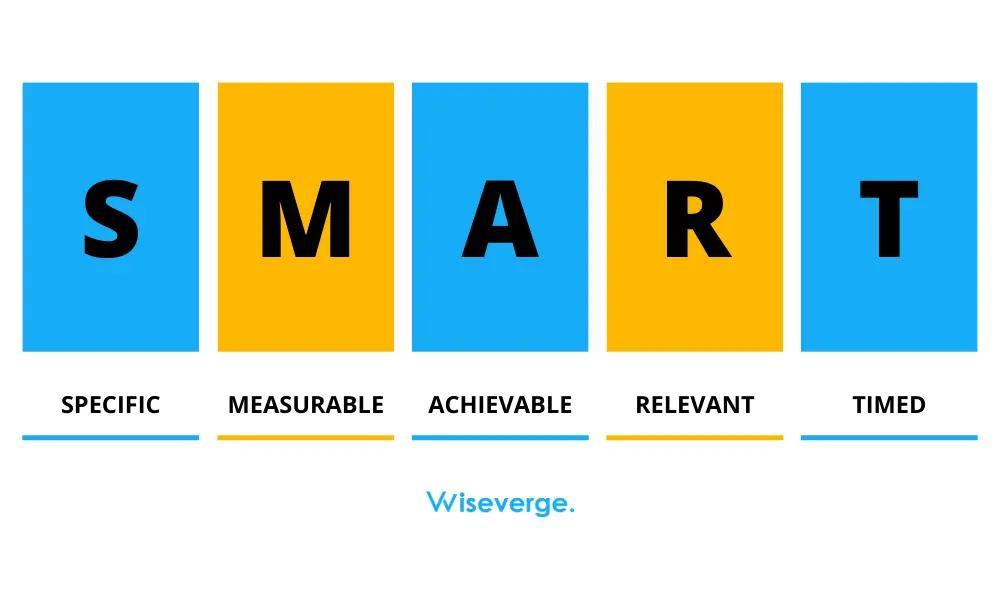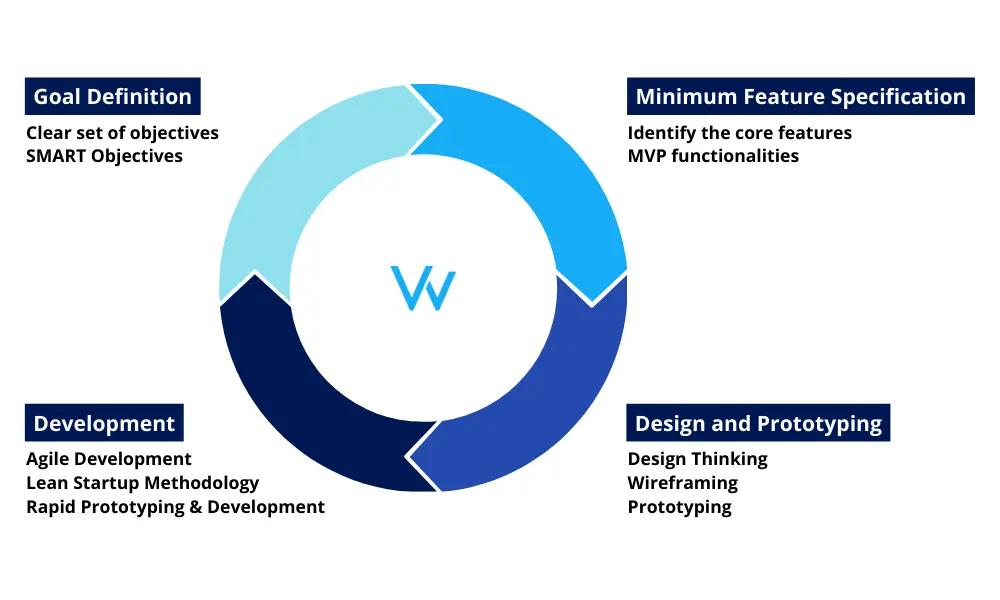MVP
MVP Development in 4 Simple Steps

Jan 12, 2024
Each day, MVP development gains space in the business world as an amazing strategy for building products and launching to test effectiveness and collect feedback from customers. Minimum Viable Product (MVP) development is a certain topic in every conversation for those aiming to achieve success in 2024 and you need to know more about it!
But what is an MVP?
An Minimum Viable Product (MVP) is the most basic version of your software that includes just enough features to satisfy early users and gather valuable feedback. It's a strategic approach that allows you to test your ideas, validate your assumptions, and minimize risks.
We write a lot about MVP product development on the Wiseverge blog and on our website as well, given our expertise. So, you can check more by accessing the MVP blog category or our MVP service page.
And in this article, we will talk more about MVP
In this guide, we'll walk you through the four simple steps of MVP development, a process that can be a game-changer for startups and established companies alike.
Let's dive in and explore how you can create a successful MVP in just four fundamental steps.
Understanding MVP Software: The Sequence of Steps to Success
In the context of software development, an MVP, or Minimum Viable Product, represents the most minimal version of an application or product, encompassing only the fundamental features necessary to address initial user requirements.
Essentially, it serves as a functional prototype aimed at testing an idea, validating assumptions, and collecting valuable feedback from users.
The MVP approach is especially valuable as it aids in risk mitigation and resource optimization, with a primary focus on delivering an initial, high-quality product that can be enhanced and expanded based on user feedback and genuine demands.
In summary, the MVP is the fundamental initial stage in the software development cycle, paving the way for product success.
To achieve success in MVP software development, it's crucial to follow defined steps that range from mapping your business goals for a specific digital product, proposing design solutions and prototypes, to selecting the most suitable development methodology. It involves defining your MVP Blueprint in alignment with your business and objectives.
Step 1: Goal Definition
Every successful MVP starts with a clear set of objectives. In this initial step, you define what you want to achieve with your MVP.
Are you looking to validate a new product concept? Or solving a specific user problem or test the waters in a new market?
Your objectives should be specific, measurable, and directly aligned with your overall product strategy. These goals will serve as your North Star throughout the MVP development process, guiding your decisions and priorities.
We have a comprehensive guide on SMART Objectives here on the Wiseverge blog. Check it out: 5 Steps to Start Your Digital Transformation.

Step 2: Minimum Feature Specification
With your objectives in place, it's time to identify the core features and functionalities your MVP should include. These are the minimum set of features required to address the most critical user needs and achieve your MVP's objectives.
The key here is to resist the temptation to add non-essential features.
Keep it simple.
By focusing on the essentials, you ensure a streamlined development process and a product that resonates with your target audience.
Step 3: Design and Prototyping
Once you've determined your essential features, it's time to visualize how your MVP will look and feel. Design and prototyping play a crucial role in creating a user-friendly experience.
This step ensures that the user interface (UI) and user experience (UX) align with your users' expectations, making it easier to gather valuable feedback.
Here are three practices, including Design Thinking, that can be applied to MVP design and prototyping:
- Design Thinking: Design Thinking is a user-centric approach that involves empathizing with users to understand their needs, defining problem statements, ideating solutions, and rapidly prototyping and testing them. It helps ensure that your MVP is aligned with the actual needs and preferences of your target audience.
- Wireframing: Wireframes are simplified visual representations of your MVP's user interface. They outline the layout and structure of your product without focusing on aesthetics. Wireframes provide a clear, visual framework for the product, helping to clarify its functionality.
- Rapid Prototyping: Rapid prototyping involves creating interactive, functional models of your MVP. These prototypes allow you to test the user flow, functionality, and usability of your product. They can be quickly modified based on user feedback, facilitating an iterative design process.
By incorporating these practices into your MVP design and prototyping phase, you can create a user-friendly and effective product that aligns with user expectations and ensures a smoother feedback-gathering process.
Step 4: MVP Development
With a clear vision of your MVP's goals, essential features, and design, you can move on to the development phase. Here, you bring your MVP to life through coding and programming.
Select the appropriate technology stack and development practices that align with your project's requirements. Focus on implementing the core features effectively. Remember, your goal is to get your MVP in the hands of users as quickly as possible.
In this phase, there are several development methodologies and practices that are specifically tailored to MVP projects, helping you achieve rapid results.
Here are three types of development methodologies:
- Agile Development: Agile methodologies, such as Scrum and Kanban, are well-suited for MVP development. They emphasize iterative development, close collaboration with stakeholders, and the ability to adapt to changing requirements. This approach ensures that your MVP can be developed in small, incremental steps, allowing for quicker delivery and feedback collection.
- Lean Startup Methodology: The Lean Startup approach, popularized by Eric Ries, focuses on building a minimum viable product as quickly as possible to test business hypotheses. It encourages a build-measure-learn cycle, enabling you to validate your assumptions and adapt your product based on user feedback and market response.
- Prototyping and Rapid Development: In the context of MVPs, rapid prototyping and development practices allow you to quickly build functional prototypes of your product. These prototypes can serve as a basis for further development or as a means to engage potential users for feedback and validation.
Selecting the right development approach depends on your specific project requirements and goals. By aligning your development methodology with your MVP objectives, you can ensure a more efficient and effective path to success.

How to simplify MVP Software Development? With expertise!
Creating a Minimum Viable Product, or MVP, doesn't have to be complicated. By following these four simple steps, you can build a powerful and effective MVP that minimizes risks and increases your chances of business success.
Start with clear goals, focus on essential features, design with the user in mind, and bring your MVP to life through careful development.
Once your MVP is in the hands of users, you'll be ready to gather feedback, make data-driven decisions, and continuously refine and improve your product.
This step-by-step approach ensures that your MVP evolves into a fully developed product that not only meets user expectations but also aligns perfectly with your business goals.
It's worth noting that a company with expertise and a dedicated focus on MVP software development can make this process even smoother. A nearshore company, like Wiseverge, can be the right choice.
We specialize in guiding businesses through these critical steps, using our experience to turn your MVP concept into a tangible reality.
Share your business idea with us and kickstart the process of launching your MVP software. With Wiseverge as your partner, your path to MVP success becomes significantly more efficient and effective.
Wiseverge - Global Software Development Agency
More articles from our blog
It seems you’re ready to take the next step
Talking with us it's free and we will probably give awesome tips.
About Us




